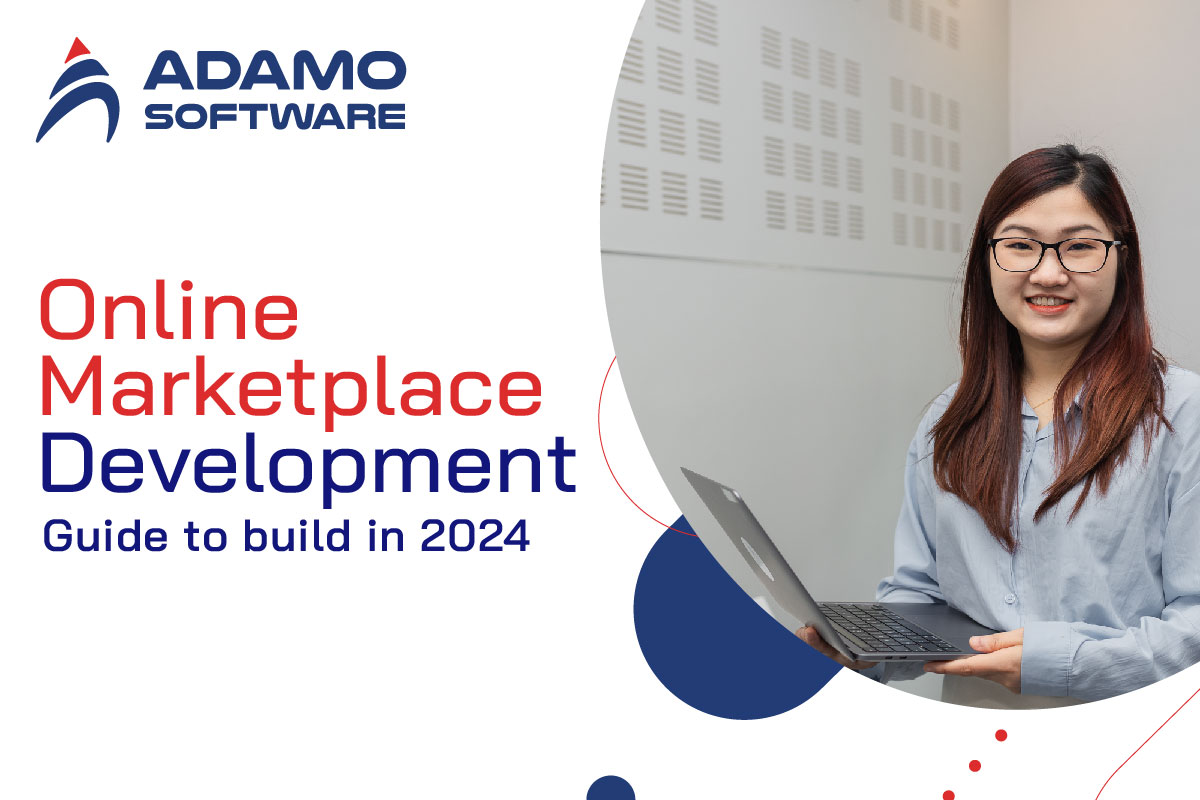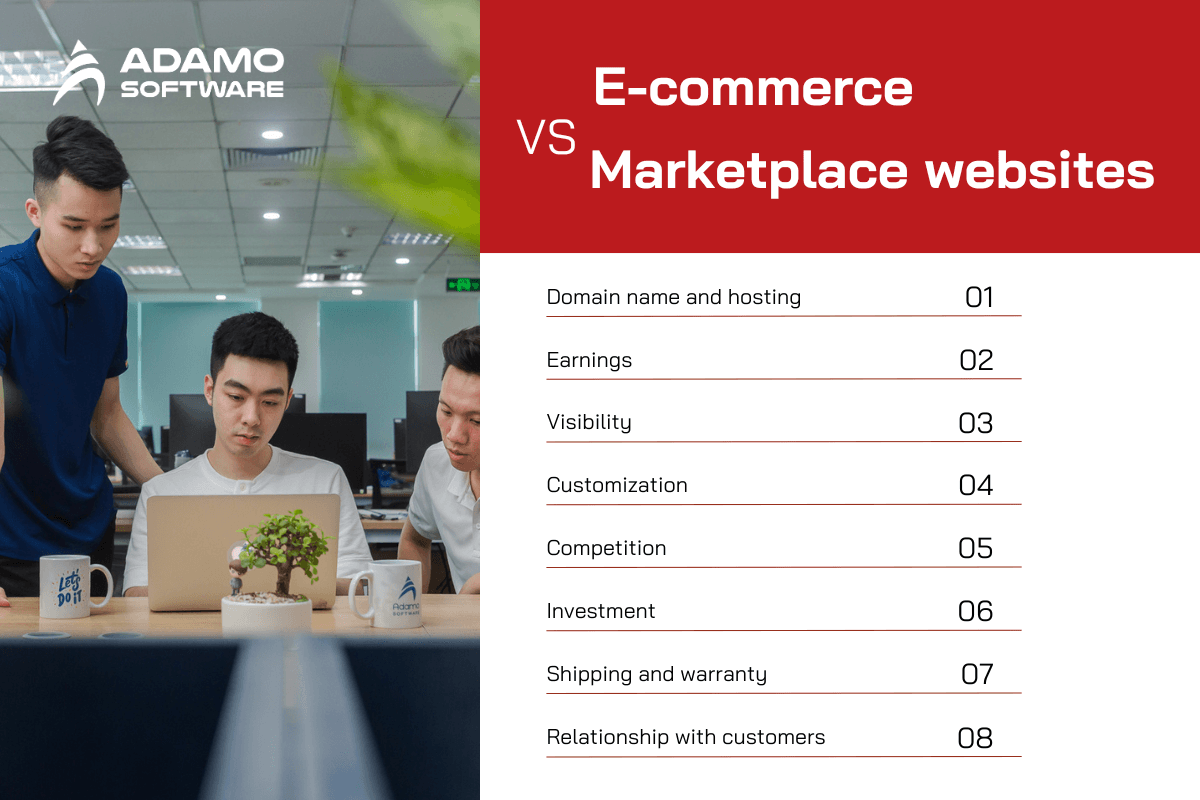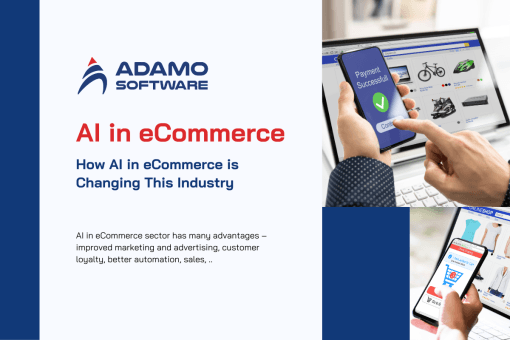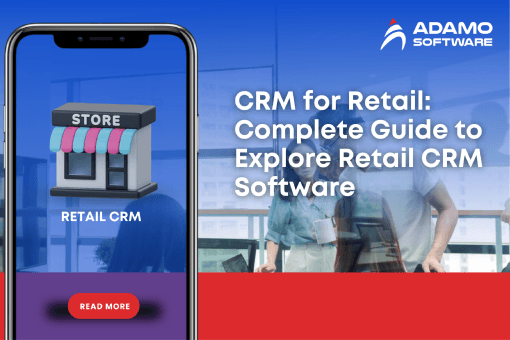Guide to Build Online Marketplace Development 2024

Influenced by the success of online marketplace development such as Airbnb, Etsy, or Fiverr? Do you want to learn how to build a marketplace? Check it out.
Experts predict that the global online marketplace development will account for more than 20% of all consumer spending by 2027. So, if you’re considering creating an online marketplace that could rival Amazon, now is the moment.
Online marketplace development needs precise planning, strategic judgments, and execution. Despite the challenges, the benefits of building a successful online marketplace are enormous, providing businesses with the opportunity to promote larger-scale transactions, create steady revenue, and establish a strong digital presence.
I. What is marketplace platform?
Unlike online stores, the online marketplace platform allows independent vendors to display their products and services.
There are several types of marketplace platforms of varying sizes, each with lots of possibilities ranging from the products that sellers offer to the marketing approach of choice. The technology and pricing will also differ depending on the marketplace’s location and purpose.
The most critical consideration is to recognize the marketplace’s position as a mediator. Marketplaces serve as a link between sellers and purchasers. As a result, the goal of a marketplace is to facilitate successful collaboration while linking buyers and sellers.
Online stores only provide their own services and items, and they have complete control over all elements, including products, prices, shipping, and payment. If you’re wondering how to start online marketplace development, keep in mind that a marketplace provides a platform for listing services as well as a payment system.
II. Classify types of marketplaces
1. Types of marketplaces by the target audience
1.1. Business-to-business (B2B)
In this online marketplace development, one company sells its services and products to other companies. The goal is not to find as many customers as possible but to build strong supply networks and long-term connections. Justdial.com and Indiamart.com are two examples of such markets.
1.2. Business-to-customer (B2C)
B2C marketplaces work directly with end users. The main goal here is to gain as many consumers as possible to create sales. Amazon.com, eBay.com, and Aliexpress.com are a few examples.
1.3. Customer-to-customer (C2C)
This online marketplace development connects the seller and customer directly and allows them to negotiate the price of the products or services. Semexe.com is an example of a C2C marketplace.
2. Based on the type of product or service
– Physical goods: This online marketplace development sells actual things, with the best examples being Amazon.com and eBay.com.
– Virtual goods: Google Play Store and Apple Store, both of which offer mobile apps, are examples of marketplaces that sell virtual products.
– Booking services: These marketplaces serve as booking interfaces for services such as hotels, cabs, flights, and vacations. Booking.com and Skyscanner.com are two examples.
– Other services: The remaining categories are job portals, freelance portals, home care services, car care services, and so on.
3. Based on the structure of sellers in the marketplace
3.1. Vertical
This online marketplace development features numerous sellers selling the same goods. For example, Protoporia.gr is a marketplace for publishing houses. Amazon.com began as a book marketplace.
3.2. Horizontal
A horizontal marketplace brings together multiple suppliers selling various products but sharing one distinct feature. For example, trsrentelco.com is an online marketplace development that sells and rents electronic testing equipment from multiple brands all under one roof.
3.3. Global
This is a 360-degree marketplace with an infinite number of products from many suppliers all around the world. Amazon.com is a perfect example of this.
III. Explore benefits of building an online marketplace
The popularity of marketplaces and the rapid growth of the market are solid reasons for online marketplace development. However, there are numerous advantages to creating an online marketplace. They are the following:
1. Cost of building marketplaces
The projected budget range for online marketplace development is comparable to that of custom software development for online store building. As a result, there is no need to spend more funds to build a marketplace from scratch.
2. Retail business without inventory management
You can start a retail business by online marketplace development without purchasing goods or inventing inventory management systems. External sellers are in charge of product storage and delivery.
3. Different revenue sources
Many people prefer to start online marketplace development because it allows them to choose from various models. Furthermore, by integrating numerous monetization strategies, business owners can earn multiple sources of money.
4. High level of automation
When starting online marketplace development, business owners receive a highly automated online business. Both sellers and buyers can communicate. All transactions are handled automatically. As a result, marketplaces require less manual management than typical internet stores.
5. Marketplaces are easy to scale up
The marketplace business model anticipates the ability to scale up a business quickly and without stress. When starting online marketplace development, keep scalability in mind so that sellers and buyers can create new accounts and easily scale up a firm.
You can also read more about A full list of online marketplaces for selling your products here
IV. How to create an online marketplace website for your business in 12 steps
1. Define your idea
Begin by identifying your marketplace’s basic concept. What kinds of goods or services will be available? Who are your target buyers and sellers? What is your unique selling proposition that distinguishes you from other platforms?
2. Conduct market research
Understand the current market, competition, and client requirements. Examine successful marketplaces to see what they’re doing right and where there are holes that your marketplace can address.
3. Develop a business model
Determine how you will create revenue. Transaction fees, listing fees, subscriptions, or a combination of these are all possibilities. Consider your price approach and how it compares to competitors.
4. Define the platform’s functionality
Outline the primary features and functionality required for your platform. This frequently includes search and discovery tools, user profiles, product listings, a secure payment mechanism, review and rating systems, and buyer and seller communication features.
5. Choose your technology
You can start online marketplace development from the ground up, use a prebuilt platform, or employ marketplace software. When making this option, keep your budget, timeframe, and technological capabilities in mind. Stripe is one example of a payment processing integration solution.
6. Build the platform
You must implement the functionality you’ve described whether you’re starting online marketplace development from scratch or using a platform. You’ll need to employ a development team if you’re not a developer yourself.
7. Test your platform
Conduct thorough testing before launch to ensure that everything functions as planned. This involves putting the purchasing and selling procedure, payment system, and all platform capabilities to the test.
8. Attract sellers
You need vendors before you can attract customers. Contact potential vendors who are a suitable fit for your online marketplace development. Consider providing incentives for people to join.
9. Launch your platform
You can launch your online marketplace development once you’ve tested everything and have some beginning sellers. Begin with a soft launch in which you invite a small group of people to test the site and provide feedback.
10. Market your platform
To attract buyers to your platform, use various marketing methods. SEO, content marketing, social media marketing, paid ads, and partnerships are all possibilities.
11. Collect and act on feedback
As users begin to utilize your platform, collect feedback to determine what is and is not working. Make use of this input to constantly improve your platform.
12. Grow and scale
Consider growth methods when your market becomes more established. This could include entering new markets or categories, developing community features, or leveraging data for personalization and suggestions.
V. Differences between e-commerce vs marketplace websites

1. Domain name and hosting
This is one of the primary distinctions since, with an eCommerce platform, you can have a personalized domain name, which can be the name of your brand or company, and your own area on the network, complete with a direct administrative panel.
Online marketplace development, on the other hand, isn’t because it’s a generic domain and hosting with restricted content management.
2. Earnings
You should be aware that the money you receive from a sale on your eCommerce platform is all yours. However, in a marketplace, because they are intermediaries, they usually charge for lists of things. Furthermore, they take a commission on each sale, and depending on the platform, they may add some additional expenses.
3. Visibility
The visibility of your items or services on the Internet is unquestionably important in increasing sales. Much depends on the marketplace’s positioning and trust in this scenario. It can be a significant benefit over a bespoke eCommerce platform, which must start from zero with positioning. However, if you work hard enough, your own platform can get top search positions.
4. Customization
The identity of your business or branding, including the values and differentiation of your brand or business, is possible to have in your own eCommerce platform. This is because development is done based on your audience, goals, and objectives.
However, online marketplace development does not provide this choice because the brand identity will not be yours. The design and the customization parameters will be those of a third party.
5. Competition
Because of the unlimited alternatives, online marketplace development may be more useful for a customer who does not know exactly what to buy. However, for sellers, this is not an advantage because a wider catalog implies more competition. In this sense, in a marketplace, visitors’ attention time on the same product decreases, however with eCommerce, the reserve occurs, because the user is browsing directly on your website.
6. Investment
Developing an eCommerce platform from the ground up is more expensive than online marketplace development. This is due to the latter’s already centralized platform. The reality is that, while establishing your own website for your online store is far more expensive in the near term, the profit margin of the sales you make via it will be much higher in the long run than those made through an online marketplace development.
7. Shipping and warranty
There is no distinction between shipping obligations. The brand from which the purchase was made is directly liable for the shipment and guarantee of the product or service in both eCommerce and the marketplace.
8. Relationship with customers
In the case of online marketplace development, the consumer interaction is restricted to the buying procedure. You will be unable to communicate with clients outside of the platform, i.e., you will be unable to send emails or newsletters announcing new launches or specials. In the case of eCommerce, you can have more direct communication with the consumer, and with their permission, you can contact them through multiple channels and keep them up to speed on your news.
VI. Essential features to create your own marketplace
1. Mobile responsiveness
Make your online marketplace development mobile-friendly. A responsive design allows for easy access and navigation, expanding your user base.
2. Scalability and performance
Create a scalable site that can handle rising traffic without sacrificing performance. Update and optimize regularly to ensure a smooth user experience.
3. Customer support and dispute resolution
For justice and great user experience, prioritize timely customer service and a transparent dispute resolution method.
4. User-friendly interface
A good first impression is essential. For seamless interactions, use straightforward navigation, clear categorization, and aesthetically beautiful design. Users must be able to simply find what they require.
5. Legal compliance and security
Ensure legal compliance while implementing strong security measures to ensure user data trust and long-term success.
6. Analytics and insights
Integrate analytics technologies to gain important information regarding user behavior, product performance, and market performance. To refine strategy and optimize functionality, make data-driven decisions.
7. Community and social integration
Social aspects can help to foster a sense of community. Users should follow vendors on social media, write comments, and share products to increase engagement.
VII. Challenges of building a marketplace website
1. Balancing supply and demand
It can be hard to find a balance between supply and demand, especially for new companies. Changes in the market and competition can make it harder for sellers and buyers to find a good mix. This can hurt users and stop online marketplace development from growing.
But how can you make a website with a store that doesn’t have this problem? You might want to add features like dynamic pricing, flexible fee structures, built-in analytics tools, easy-to-use seller onboarding processes, and regular technical support.
2. Quality control
It can be hard to make sure that the quality of goods and services in an online marketplace development is always the same because there are so many sellers and customers have high expectations. Sellers must follow the platform’s quality rules by undergoing regular quality checks.
Also, letting buyers rate sellers and write reviews for goods and services can make the user experience better and help people make better decisions. Adding ways to settle disagreements can increase happiness even more.
3. Changing market dynamics
Online marketplace development is always changing people’s tastes can shift as quickly as the weather. For a platform to be successful, it needs to keep up with these changes and make changes to its products, marketing strategies, and user experiences as needed.
You can get around this problem with a scalable system and integrations that make your online marketplace development more useful.
VIII. How much does it cost to build a marketplace?
| Stages | Average Cost (per hour) | Time involved | Recommended Tools |
| Market Research | $5,000 to $7,000 | 4 weeks to 8 weeks | – Survey Monkey – Qualtrics – Google Trends – Statista |
| Business planning | $3,000 to $5,000 | 5 weeks to 8 weeks | – VRIO Framework – SWOT Analysis – PESTLE Analysis – Porter’s Five Forces |
| Design and prototyping stage | $5,000 to $10,000 | 4 weeks to 6 weeks | – Adobe XD – Figma – Axure – Balsamiq – InVision |
| Development stages – Frontend Development – Backend Development – AWS Setup (you can take use of any other setup as well) – Selecting your price model – Developing MVP model – Develop key metrics for your business | $10,000 to $30,000 | 8 weeks to 12 weeks | – Github – React – HTML5 Builder – My SQL – Vue.js – Axure – Postgre SQL – MongoDB |
| Testing & Quality assurance | Approx 10% to 15% of the development cost | 4 weeks to 6 weeks | – Postman – Selenium – JMeter – Cypress |
| Final deployment stage | $2,000 to $4,000 | 2 weeks to 4 weeks | – Amazon Web Services (AWS) |
IX. Why Choose ADAMO for building an online marketplace development
Recently, the e-commerce marketplaces are emerging as a boom in today’s dynamic business landscapes for its tremendous benefits and influences. Understanding that situation, Adamo has leveraged the market and the latest technologies to empower lucrative software development solutions in the e-commerce field. With our experienced software developers and thoroughly exploring business opportunities, the Adamo team will be an ideal tech partner for those who want to drive their business operations. We have partnered with many key players in e-commerce industry in Singapore, Hong Kong, Philippines and Australia as well. We are confident in providing money-making software solutions with innovative technologies. Contact us if you want to transform your business ideas into a real business solution.
FAQs for Online marketplace development
1. Why building marketplaces is popular in today’s business landscapes and how do they stand out from competitors?
The first reason to start online marketplace development is to give people different ways to make money. You can make money in a lot of different ways, such as through ads, registration fees, commissions, or listing fees.
The second thing is that online markets are known for growing quickly. As long as everything works right from the start, there will be a lot more buyers and traders very quickly.
Last but not least, marketplace owners don’t have to deal with any problems that come with managing goods because they don’t have any. The same goes for shipping or moving things around. The vendors oversee these steps. The owner of the online marketplace development is in charge of setting up a website where buyers and sellers can meet and do business.
2. Why do enterprises outsource an online marketplace development service in Southeast Asia, particularly in Vietnam?
Vietnam, Indonesia, Philippines, Cambodia, Myanmar, Thailand, and Malaysia are among the most popular IT offshore destinations today. Tech JDI found that Vietnam has great technology talent. The best value/quality ratio is an essential reason to outsource online marketplace development services from Vietnam.
Furthermore, labor costs in Vietnam are 15%–50% lower than in Thailand and Malaysia. In Vietnam, hiring a data engineer or software engineer costs 9,600 to 18,000 USD per year, while in Singapore, it costs 38,000 to 84,500 USD. This appeals to enterprises worldwide.
3. Why should you choose Adamo for creating your own marketplace platform?
Adamo Software has been starting online marketplace development since 2018. We have built dozens of eCommerce platforms of varying complexity for various sectors over the years. They all paid off immediately and became thriving businesses.
Furthermore, we have extensive expertise in successfully conducting discovery sessions. It means that we have learned to gather basic requirements from customers and provide them with the most appropriate technical solutions in a timely and easy manner.
This methodology enabled Adamo Software to specify how to start online marketplace development that fit specific customer expectations while also providing value to end consumers.
4. How to build an online marketplace that attracts consumers?
Research the market and take note of rivals’ offers to ensure that your new online marketplace development is appealing to the target market. But don’t just make a website like Amazon. Instead, take the greatest aspects from it, such as a fashionable, smart, and user-friendly user interface and data security measures, and add your own.
Next, define your value proposition and check that it meets the needs of your target audience. Finally, promote your marketplace with marketing campaigns, advertising, referral programs, and partnerships, as well as by utilizing SEO and, of course, collecting and acting on feedback.
5. What are the main differences between marketplaces and e-commerce platforms?
While both marketplaces and eCommerce platforms are used for buying and selling goods and services, their business models and modes of operation differ. Consequently, sellers or vendors in online marketplace development often provide a wide range of goods and services in several categories. Most marketplace systems make money by charging a commission on each sale.
E-commerce platforms typically specialize in a single product category, such as electronics, fashion, or software. They make money through product sales, subscription fees, or a mix of the two.
6. What are the estimated costs of building a marketplace?
The cost of online marketplace development varies depending on aspects such as the app’s complexity, the platform (iOS, Android, or both), the number of features, and the rates of the development team. A marketplace app’s development costs might range from a few thousand to hundreds of thousands of dollars.








